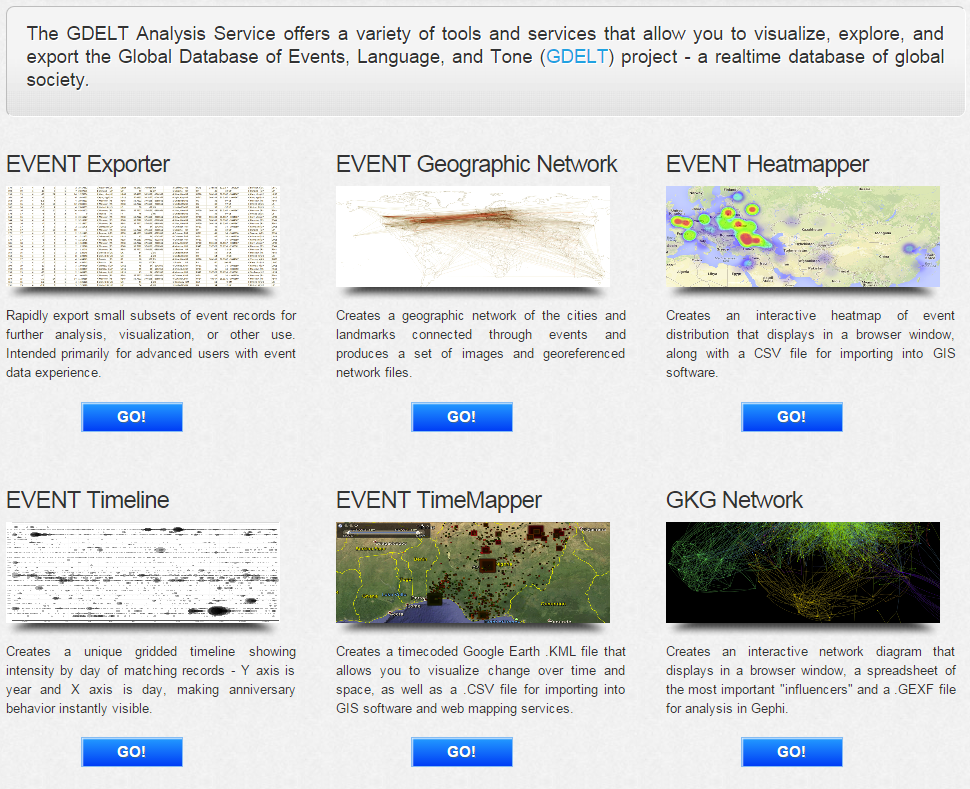The Global Database for Events, Language, and Tone or GDELT Project supported by Google Ideas, monitors global media (in more than 100 languages) and identifies key people, locations, organizations, conflict, and themes. GDELT already has a lot of great features and is moving towards 2.0 with more contextualized geocoding.
GDELT consists of two databases: 1) an Event and 2) Global Knowledge Graph (GKG) database. The event database is more focused on what and where, while the GKG focuses on 'how something is being said. With the Event database, you can search by actor (initiator and victim) and by category of exchange / different type of event codes. With the GKG, you can search by keyword.
 One day's worth of events mapped above. Click the map to enlarge it.Accessing and downloading data
One day's worth of events mapped above. Click the map to enlarge it.Accessing and downloading data
GDELT data can be accessed in a number of ways for a wide range of users from beginner's to advanced. You can utilize the Analysis Service, Google Cloud, or raw data--in this case event data. A lot of the data sets are tab delimited. Column names can be found in the documentation. Skip to the bottom of this article for more links!
Analysis Service
I have spent most of my time exploring the analysis service that allows you to export raw data, map it, view timelines and a host of other great features. It provides all sorts of tools to access, export, and analyze data including creating heat maps, dynamic KMLs, timelines, network diagrams, graphs tone graphs, and word clouds!
 GDELT's Analysis Service makes the data very accessible.There is too much to describe, so check it out for yourself by visiting the links below! Be sure to read through the documentation before getting started!
GDELT's Analysis Service makes the data very accessible.There is too much to describe, so check it out for yourself by visiting the links below! Be sure to read through the documentation before getting started!
GDELT Analysis
http://analysis.gdeltproject.org/
Raw Data
http://gdeltproject.org/#downloading
http://data.gdeltproject.org/events/index.html
Documentation and Column Names
http://gdeltproject.org/data.html#documentation
http://data.gdeltproject.org/documentation/GDELT-Data_Format_Codebook.pdf
Conflict Dashboard
http://gdeltproject.org/globaldashboard/
أكثر...
"[GDELT's] Event Database archives contain nearly 400 million latitude/longitude geographic coordinates spanning over 12,900 days,...making it one of the largest open-access spatio-temporal datasets in existence." - GDELT website
Event vs. GKG databasesGDELT consists of two databases: 1) an Event and 2) Global Knowledge Graph (GKG) database. The event database is more focused on what and where, while the GKG focuses on 'how something is being said. With the Event database, you can search by actor (initiator and victim) and by category of exchange / different type of event codes. With the GKG, you can search by keyword.
GDELT data can be accessed in a number of ways for a wide range of users from beginner's to advanced. You can utilize the Analysis Service, Google Cloud, or raw data--in this case event data. A lot of the data sets are tab delimited. Column names can be found in the documentation. Skip to the bottom of this article for more links!
Analysis Service
I have spent most of my time exploring the analysis service that allows you to export raw data, map it, view timelines and a host of other great features. It provides all sorts of tools to access, export, and analyze data including creating heat maps, dynamic KMLs, timelines, network diagrams, graphs tone graphs, and word clouds!
GDELT Analysis
http://analysis.gdeltproject.org/
Raw Data
http://gdeltproject.org/#downloading
http://data.gdeltproject.org/events/index.html
Documentation and Column Names
http://gdeltproject.org/data.html#documentation
http://data.gdeltproject.org/documentation/GDELT-Data_Format_Codebook.pdf
Conflict Dashboard
http://gdeltproject.org/globaldashboard/
أكثر...
